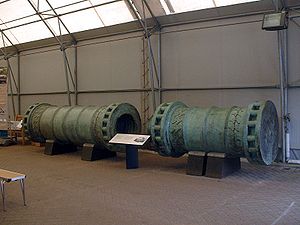| Dardanelles Gun | |
|---|---|
 Dismantled Dardanelles Gun at Fort Nelson, Hampshire, overlooking Portsmouth | |
| Type | Bombard |
| Service history | |
| Used by | Ottoman Empire |
| Wars | Dardanelles Operation (1807) and Battle of the Dardanelles (1807) |
| Production history | |
| Designer | Munir Ali[1] |
| Designed | 1464[1] |
| Specifications | |
| Mass | 16.8 t[2] |
| Barrel length | 518 cm[1] |
|
| |
| Elevation | none |
| Traverse | none |
The Dardanelles Gun[3] (Şahi in Turkish) or Great Turkish Bombard[2] is a 15th-century siege cannon, specifically a super-sized bombard, which saw action in the 1807 Dardanelles Operation.[4]
History[]
The Dardanelles Gun was cast in bronze in 1464 by Munir Ali with a weight of 16.8 t and a length of 518 cm, being capable of firing stone balls of up to 63 cm diameter.[1] The powder chamber and the barrel are connected by the way of a screw mechanism, allowing easier transport of the unwieldy device. Such super-sized bombards had been employed in Western Europe siege warfare since the beginning of the 15th century,[5] and were introduced to the Ottoman army in 1453 by the gunfounder Orban (from Brasov, Kingdom of Hungary) on the occasion of the Siege of Constantinople.[6] Ali's piece is assumed to have followed closely the outline of these guns.[6]
Along with a number of other huge cannons, the Dardanelles Gun was still present for duty more than 350 years later in 1807, when a Royal Navy force appeared and commenced the Dardanelles Operation. Turkish forces loaded the ancient relics with propellant and projectiles, then fired them at the British ships. The British squadron suffered 28 dead through this bombardment.[4]
In 1866, on the occasion of a state visit, Sultan Abdülâziz gave the Dardanelles Gun to Queen Victoria as a present.[6] It became a part of the Royal Armouries collection and was displayed to visitors at the Tower of London and was then moved to Fort Nelson, Hampshire, overlooking Portsmouth.[7]
See also[]
Notes[]
- ↑ 1.0 1.1 1.2 1.3 1.4 Schmidtchen (1977b), pp. 226–228
- ↑ 2.0 2.1 http://www.royalarmouries.org/visit-us/fort-nelson/galleries/single-object/196
- ↑ Ffoulkes (1930), pp. 217–227; Schmidtchen (1977b), pp. 226–228
- ↑ 4.0 4.1 Schmidtchen (1977b), p. 228
- ↑ Schmidtchen (1977a), pp. 153–157
- ↑ 6.0 6.1 6.2 Schmidtchen (1977b), p. 226
- ↑ "Geometry of War – Pg. 6" (PDF). http://www.math.nus.edu.sg/~mathelmr/gem-projects/maa/Geometry_of_War.pdf.
Sources[]
- Ffoulkes, Charles, "The 'Dardanelles' Gun at the Tower", Antiquarian Journal, Vol. 10 (1930), pp. 217–227
- Schmidtchen, Volker (1977a), "Riesengeschütze des 15. Jahrhunderts. Technische Höchstleistungen ihrer Zeit", Technikgeschichte 44 (2): 153–173 (153–157)
- Schmidtchen, Volker (1977b), "Riesengeschütze des 15. Jahrhunderts. Technische Höchstleistungen ihrer Zeit", Technikgeschichte 44 (3): 213–237 (226–228)
External links[]
| Wikimedia Commons has media related to Dardanelles Gun. |
The original article can be found at Dardanelles Gun and the edit history here.